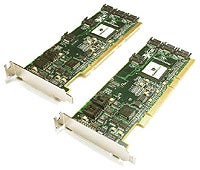A big differentiator between dedicated servers and regular PCs is the disk I/O interface. Servers typically include RAID controllers, and they usually look to SCSI drives rather than ATA drives to obtain the best performance. That may no longer be necessary or desirable, however, as the latest RAID controllers with Serial ATA (SATA) drives can hold their own with SCSI160 and even SCSI320 systems in terms of performance, and they do so at much lower price points. And in some cases, the SATA controllers even perform better than their SCSI counterparts.

RC4000 SATA RAID Controllers
The RAIDCore RC4000 line of SATA controllers is comprised of 64-bit, 133 MHz (PCI-X) low-profile cards that offer four- or eight-drive support. They deliver a solid feature set, outstanding performance, and a lower price point than comparable SCSI controllers.
We tested the RC4452 four-drive controller, which has a list price of $289, using four Hitachi (IBM) HDS722580VLSA80 80 GB 7200 RPM drives. Our results? A maximum performance of 161 MB per second on reads and 102 MB per second on writes,
One reason the high-performing line is able to carry such a relatively inexpensive price point is that it uses the host PC’s CPU for RAID processing. Although one would expect this to lead to relatively high CPU utilization during disk testing, the utilization peaked at lower than 8 percent.
Using the host CPU is advantageous for another reason. According to RAIDCore, this is what enables the product to offer sophisticated features such as online capacity expansion, online RAID-level migration, and controller spanning (creating volumes across multiple controllers).
The controller supports the standard RAID levels of 0, 1, and 5, as well as 10, 0+1 – mirrored and spanned, and 1n and 10n, which allow multiple parity drives for extra redundancy — i.e., more than one drive can fail and the integrity of the array will be maintained. It can split mirrored arrays (RAID 1), as well as hide arrays from the operating system to enable secure backups.
The controller can also keep track of where each drive in an array belongs. So, if, for example, cables are switched during a drive replacement, the array is not scrambled. It also supports what RAIDCore calls a distributed hot spare — a small partition is left available on each drive, and the combined extra space is used to create a virtual hot spare, rather than using a dedicated drive.
Installation and Performance
Installing the controller is simple and connecting the drives is straightforward, as the SATA cables make things easier than the old IDE cables. After the drives and controller are installed, the controller is accessible through the BIOS during boot-up, the array is configured, and the driver is installed under Windows. Once this is done, the array is available for use and can be managed through a RAIDCore Windows application as well as through the BIOS.
While individual drive performance with SATA drives is, at best, comparable to SCSI 320, the different approach in RAID controllers may yield better overall performance, especially with large numbers of drives. This is because the SCSI320 bus is shared among all the drives attached to a controller, whereas SATA bus requirements result in each drive being on a separate bus. This limits overall throughput to the system bus – PCI-X 64/133 or PCI Express – rather than the 320 MB per second speed of the SCSI320 bus.
Although we were not able to test the RAID controller with enough drives to go beyond 320 MB per second, previous tests have shown that SATA arrays can scale linearly up to 32 drives (with four eight-drive controllers). They produce RAID 5 reads of more than 350 MB per second with eight drives, more than 700 MB per second with 16 drives, and more than 1 GB per second with 32 drives. This is well beyond SCSI320’s capabilities, and the lower price point should only sweeten the deal.
Vendor Home Page: RAIDCore
Product Home Pages: RAIDCore RC4452 SATA RAID Controller
Platform:Windows XP, 2000,2003 Server; Linux drivers scheduled to be available soon.
Size: 2U module
Price: $289 for four-drive controller; $362 for eight-drive controller
Pros: High performance, low cost, solid feature set, array can be upgraded or reconfigured on the fly, low-profile card fits 2U servers.
Cons: Currently supports only Windows 2000 Workstation and Server, Windows XP, and Windows 2003 Server.
Feature adapted from ServerWatch.
Back to Enterprise Storage Forum


